
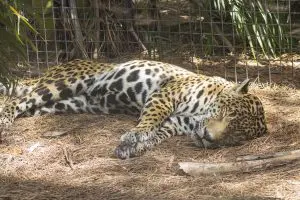
Masaya lounges in her habitat located in the Rainforest Revealed loop.
Old in age but young at heart, let’s meet some of our Zoo’s senior residents!
Each of these animals bring a lifetime of experiences reflected in their own unique charm. Read on to learn more about how we prioritize animal wellbeing for our older residents and keep them thriving in their golden years!
Rainforest Revealed: Masaya and Pepper
Despite being quite older, our 16-year-old cheetah, Pepper, and our 20-year-old jaguar, Masaya, are living their best lives!
Age doesn’t slow down these feline ladies as they eagerly engage in daily training sessions. They also interact with all sorts of enrichment items that encourage their natural behavior, like hidden food and toys, said Rainforest Revealed area supervisor Grace Scott.
The two are also being trained for voluntary blood draws. This behavior, rewarded with positive reinforcement, makes monitoring their health as they age much easier! Additionally, they extra vitamins, like digestion aid and nutritional supplements, to support their health.
“Masaya is one of the oldest jaguars in zoos—there are only a handful under human care that are in or above her age range,” Grace said. “And we like to say Pepper is going to live forever due to her passing the expectancy of her species and having excellent quality of life for her age.”
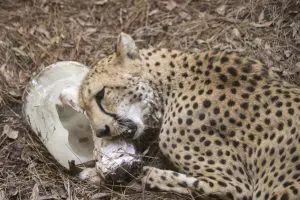
Pepper snacks on a meat bone.
Thanks to their dedicated care, training and enrichment, these big cats are still playful and lively as ever!
Wild Florida: Killer, Gollum and Lily
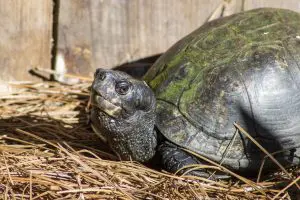
Killer is one sassy turtle!
Killer, our Gulf Coast box turtle, is about 60 years old, but don’t let this number fool you! While most may consider 60 “old,” his species lives up to around 100 years old or more.
This little turtle receives standard care for his species and is thriving and healthy! He is particularly territorial and attempts to bite keepers’ feet anytime they enter the habitat.
“We joke that he ‘thinks he’s though stuff,’ which is what earned him the moniker ‘Killer,’ even though he’s a three-pound turtle,” joked Herps & Aquatics area supervisor Nicole Payne.
When he’s not submerged in his pond, you can find him sunbathing in his habitat!
Lilly, 37, and Gollum, 38, are American crocodiles who have been with us for over 20 years! Both crocs receive plenty of training that allows them to participate in their medical care like voluntary injections, weight checks and ultrasounds.
We also keep up with their enrichment, including a new pulley system! This positions their food deliveries at varying heights to challenge and entertain them.
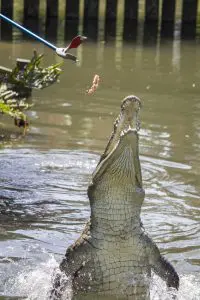
One of our crocodiles leaps for a bite of food!
American crocodiles live to about 50 to 70 years old. In reality, these two aren’t all that old, but this is nothing new for our Herps & Aquatics animals.
“Age is just a number,” Nicole said. “A lot of reptiles live a really long time, thanks in part to their slower metabolism. Reptiles are just awesome that way!”
Lands of Change: Morticia and Jacie
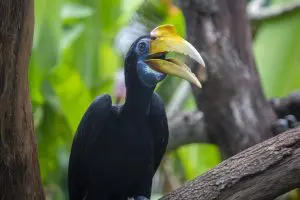
Morticia joined our Zoo’s family in 2004.
Morticia, our 31-year-old wrinkled hornbill, has come a long way. Her species typically only lives into their 30s, making Morticia one of the oldest females in the population of wrinkled hornbills living in Association of Zoos and Aquariums-accredited facilities.
For the past six months, she has been dealing with several medical conditions, including heart disease and an enlarged liver, which she takes daily medications for. Additionally, her cataracts have caused the bird to lose some sight in her left eye.
Because of her age and declining health, Morticia can struggle at some times, but she is still staying strong. She particularly loves playing catch with her favorite snacks: figs and grapes!
To accommodate Morticia, our keepers redesigned her habitat to make it easier for her to hop from branch to branch. And of course, they keep a close eye on any changes in behavior or health.
Thirteen-year-old red kangaroo Jacie has been under our care for over a decade now. Earlier this year, our veterinary staff discovered during a routine exam that Jacie is unfortunately developing arthritis in her leg joints.
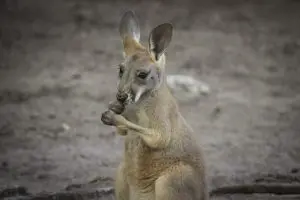
Jacie has been with us since she was just a joey!
Though we haven’t seen any decline in mobility, we wanted to take care of the condition in its early stages.
“By finding things like arthritis before they begin to cause stiffness or discomfort, we can start treatment options to help her stay bouncy on her feet!” said Lands of Change area supervisor Kristen Gagnon.
So, we began voluntary laser therapy each week to reduce pain and inflammation, which Jacie quite enjoys!
Partially hand-raised and gentle in demeanor, Jackie has always been a “keeper favorite,” said Kristen. Her arthritis doesn’t hold her back—she is still her sweet, curious and friendly self.
Expedition Africa: Milenna
Milenna, our Masai giraffe, is an older lady, but she’s still full of spunk and personality! The 22-year-old giraffe has surpassed the median lifespan of female giraffes of 20.2 years old, according to the Association of Zoos and Aquariums survival statistics.
Milenna eats her grain separately from our other giraffes in the morning and evening, to ensure our keepers can keep a close eye on her diet consumption. Other adjustments include hanging her enrichment at a higher position, so she doesn’t have to bend down as often.
As giraffes age, their hooves can wear down. So, we worked with the Zoo Hoofstock Trim Program to handmake rubber polyethylene shoes to relieve some of that pressure and discomfort. We continue to monitor her closely to ensure she’s comfortable, sometimes using medication to keep her as pain-free as possible.

Milenna gets her shoes fitted.
Milenna gets her shoes fitted.
Though she’s slowed down in recent years because of some mobility struggles, believe us—Milenna’s personality has not dulled a bit! Often times, she will lightly nudge keepers with her ossicones if they aren’t paying attention.
“It’s nothing aggressive—just a little sass to say ‘Hurry up! I want my food,’” said Africa Barn area supervisor Tammi Thompson Cunigan. “Who can say no to her?”
Siamang Island: Pete and Sapphire
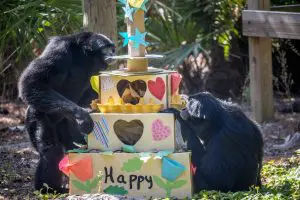
We celebrated Pete and Sapphire’s 46th birthday earlier this year.
In human care, Siamangs usually live to about 40 years of age, but our dynamic duo, Pete and Sapphire are both 46 years old!
This inseparable pair spend their days lounging in “Siamang Island” nested between Expedition Africa and Lands of Change. Adorned with climbing vines and structures, our keepers are constantly thinking of ways to refresh the island space and keep things exciting!
We celebrated Pete and Sapphire’s 46th birthday earlier this year.
“Their habitat gives them a lot of choice and control, which contributes to their wellbeing and is also a major factor in longevity,” said Expedition Africa keeper Cindy Watson.
And as they age, we adapt! The two have mastered open mouth behaviors to let keepers take photos of their teeth, as they have age-related dental issues. They are also given medication and a modified diet to include softer, more palatable foods like cooked veggies instead of raw ones and kernels instead of corn on the cob. Plus, their diet items are doubled as enrichment to keep their minds in tip-top shape!
Pete and Sapphire are also one of our most affectionate pairs at our Zoo. Having been by each other’s side for over 30 years, Pete and Sapphire often snuggle, groom each other and sing together, which is a natural bonding behavior for the species.
As they are healthy for their age, we’re certain their enduring connection will last a lifetime.
________________________________________________________________________________________________________________________________________________________________________
Our senior animals’ care highlights the importance of the dedicated attention that our Zoo is committed to providing. By understanding our animals through and through, we can give them a nurturing environment at every stage of life.
Special thanks to Flammio Financial Group, Stifel-Garvin Wealth Management Group, Artemis IT, and Jim and Darleen Barfield. Their generosity makes our work possible!
Brevard Zoo is an independent, not-for-profit organization that receives no recurring government funding for our operating costs. Your generous support enables us to continue to serve our community and continue our vital animal wellness, education and conservation programs.
